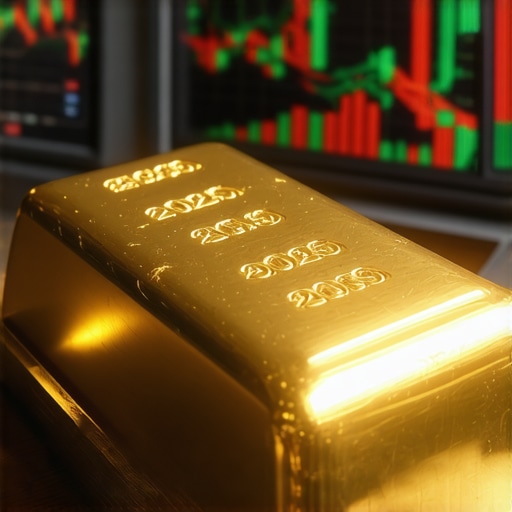Understanding the Influence of Central Banks on Gold Prices
The relationship between central banks and gold prices is a crucial aspect of the financial landscape that every investor should understand. Central banks play a significant role in the economy, influencing monetary policy, interest rates, and currency values, all of which can directly impact gold prices. As a safe-haven asset, gold often reacts to the policies and actions of these institutions, making it essential for investors to stay informed about how central banks affect gold pricing.
Gold has long been viewed as a hedge against inflation and economic instability. When central banks implement policies such as quantitative easing or low-interest rates, they increase the money supply, which can lead to a depreciation of currency values. As a result, many investors turn to gold to preserve their wealth. For instance, during times of economic uncertainty, central banks may increase their gold reserves to bolster confidence in their financial systems. This increased demand can drive up gold prices significantly, creating opportunities for savvy investors.
Central Banks and Gold Reserves: A Historical Perspective
Historically, central banks have maintained substantial gold reserves as part of their monetary policy. These reserves serve as a buffer against currency fluctuations and economic downturns. For example, the Gold Market Analysis: Current Trends and Future Predictions highlights how central banks have significantly increased their gold holdings in recent years, particularly in response to global economic uncertainty. This trend reflects a growing recognition of gold’s value as a stable asset amidst volatile market conditions.
Moreover, central bank actions can influence market sentiment regarding gold. When banks announce plans to buy or sell gold, it can create ripples throughout the market, affecting prices almost immediately. For instance, if a major central bank reveals it is purchasing gold, it can signal to investors that they should also consider increasing their gold investments. This phenomenon often leads to price surges, as demand escalates in anticipation of future price increases.
Impact of Interest Rates on Gold Prices
Interest rates set by central banks also play a pivotal role in determining gold prices. Lower interest rates reduce the opportunity cost of holding gold, as it does not yield interest like bonds or savings accounts. Consequently, when central banks lower rates, gold often becomes more attractive to investors. During periods of low rates, as outlined in the post How Gold Acts as a Hedge: Insights for Today’s Investors, gold prices typically rise as demand increases.
Conversely, when central banks raise interest rates, gold can lose its appeal, leading to a decline in prices. Investors may shift their portfolios towards interest-bearing assets, which can create downward pressure on gold prices. Understanding the delicate balance between interest rates and gold pricing is crucial for investors looking to navigate the complexities of the gold market.
In conclusion, the impact of central banks on gold prices is multifaceted and significant. As they influence monetary policy and interest rates, investors must remain vigilant and informed about these changes. For those interested in the long-term benefits of gold as an investment, exploring strategies to incorporate it into a diversified portfolio is essential. For further insights, consider reading Gold Investment: A Comprehensive Guide to Buying Gold.
Economic Events That Affect Gold Prices
Economic events play a pivotal role in shaping the market dynamics of gold prices. Key indicators such as inflation rates, employment statistics, and GDP growth can significantly influence investor sentiment and decision-making. For instance, when inflation rates rise, the purchasing power of currency decreases, prompting investors to seek refuge in gold as a hedge against inflation. This trend is explored in detail in the article Understanding Gold as a Hedge Against Inflation.
Moreover, unexpected economic shocks, such as financial crises or geopolitical tensions, can lead to sudden spikes in gold demand. Investors often flock to gold during turbulent times, driving prices higher. Understanding these economic events is crucial for anyone looking to navigate the gold market effectively.
The Role of Economic Indicators in Gold Trading
Economic indicators are vital tools that traders and investors use to gauge the health of the economy and anticipate potential movements in gold prices. For example, reports on employment rates can provide insights into economic stability. A robust job market typically correlates with a strong economy, which might decrease demand for gold. Conversely, a high unemployment rate may lead to increased gold investment as a safe-haven asset.
Additionally, GDP growth figures can also influence gold prices. A growing economy may result in a stronger currency, which could diminish gold’s appeal. For a comprehensive overview of these factors, consider reading Gold Price Trends: Essential Factors Impacting Values.
Geopolitical Factors and Their Influence on Gold Markets
Geopolitical events, such as conflicts, trade wars, and political instability, can dramatically affect gold prices. Gold is often seen as a safe-haven asset during times of uncertainty. For example, during heightened tensions between nations or in the face of political upheaval, many investors are likely to turn to gold to safeguard their wealth. This phenomenon is not only limited to immediate crises but can also extend to ongoing tensions that create a climate of uncertainty.
Furthermore, the impact of central bank policies on gold can be exacerbated by geopolitical factors. If a country’s political situation becomes unstable, its central bank may take drastic measures that could influence currency values and, consequently, gold prices. Understanding these dynamics can provide investors with a strategic advantage in the gold market.
Understanding Supply and Demand Dynamics in Gold Trading
The fundamental principles of supply and demand are essential in shaping the price of gold. When demand for gold rises, prices typically follow suit. Factors contributing to increased demand include economic instability, inflation concerns, and increased investment in gold-backed financial products. Conversely, if the supply of gold increases significantly—due to mining growth or central banks selling their reserves—this can lead to downward pressure on prices.
Investors should also consider the implications of gold production and mining output on market dynamics. For insights on the best gold investments and strategies, check out Best Gold Investments for Beginners: Tips and Strategies.
Strategies for Investing in Gold Amid Economic Changes
To successfully navigate the complexities of the gold market, investors must develop effective strategies that align with economic conditions. These strategies might include diversifying their portfolios with gold ETFs, investing in gold mining stocks, or purchasing physical gold. Understanding the nuances of these investment types can provide a competitive edge in uncertain markets.
For investors new to gold, it is crucial to understand the different avenues available for investment. Whether considering Gold Bullion vs. Gold Coins: Which is the Better Investment? or exploring gold IRA options, being informed is key to making sound investment decisions. This knowledge can help mitigate risks and maximize potential returns in fluctuating economic climates.
Long-Term vs. Short-Term Gold Investment Strategies
When considering gold investments, it is essential to decide between long-term and short-term strategies. Long-term investors typically focus on accumulating gold as a stable asset that appreciates over time, providing a hedge against inflation and economic instability. This approach aligns well with insights from Gold Investment: A Comprehensive Guide to Buying Gold, which emphasizes the importance of understanding market cycles and the overall economic landscape.
On the other hand, short-term investors might engage in trading gold based on market fluctuations, seeking to capitalize on price volatility. This strategy requires a keen understanding of market trends and technical analysis. For those interested in honing their trading skills, the post Ultimate Guide to Gold Trading Techniques for Newbies offers valuable tips and techniques.
The Importance of Diversification in Gold Investments
Diversification is a crucial principle in investing, and it holds true for gold as well. By spreading investments across various forms of gold—such as physical gold, gold ETFs, and gold mining stocks—investors can mitigate risks associated with market volatility. For instance, while physical gold can serve as a hedge against economic downturns, gold ETFs can offer liquidity and flexibility in trading.
Moreover, exploring Gold Stocks and Mutual Funds: Diversifying Your Portfolio can provide insights into how these investment vehicles can complement a well-rounded gold investment strategy. Understanding the correlation between different gold investment types can enhance portfolio performance.
Analyzing Gold Market Trends and Future Predictions
Staying informed about market trends is vital for any investor. Analyzing historical data and current market conditions can aid in predicting future price movements. For example, understanding how supply and demand dynamics impact prices can help investors make informed decisions. The post Gold Price Forecast: Trends to Watch in 2025 discusses essential factors that could influence gold prices in the coming years.
Additionally, keeping an eye on geopolitical events and central bank policies can provide critical insights into market stability. As mentioned in our previous sections, these factors often drive gold demand, especially during times of uncertainty.
Impact of Inflation on Gold Investment Strategies
Inflation is a significant factor to consider when developing gold investment strategies. Gold is often viewed as a hedge against inflation, with its value typically rising when the cost of living increases. Investors should monitor inflation rates and adjust their strategies accordingly. This consideration is particularly relevant for those exploring How Gold Acts as a Hedge: Insights for Today’s Investors.
Furthermore, understanding how inflation affects purchasing power can help investors make more informed decisions about timing their investments in gold. Strategies that account for inflation can position investors for long-term success in an unpredictable market.
Understanding Gold Demand Patterns for 2025
As we look towards 2025, understanding gold demand patterns becomes increasingly crucial for investors. Various factors contribute to gold demand, such as jewelry consumption, industrial usage, and the investment sector. The Gold Demand Patterns: Critical Data for 2025 Investors article provides an in-depth analysis of these trends, ensuring that investors can make informed decisions based on projected demand fluctuations.
Jewelry remains a significant contributor to gold demand, especially in markets like India and China. As economies in these regions grow, the demand for gold jewelry is likely to rise, which can drive up prices. Additionally, the investment demand, particularly in the form of gold ETFs and bars, continues to be a vital aspect that investors should monitor closely.
Evaluating Gold Investment Portfolios for Future Success
Investors should regularly evaluate their gold investment portfolios to ensure alignment with their financial goals and market conditions. A well-balanced portfolio that includes various gold assets—such as physical gold, ETFs, and mining stocks—can offer protection against market volatility. For guidance on this topic, refer to Steps to Evaluate Your Gold Investment Portfolio, which outlines effective strategies for portfolio assessment.
Moreover, understanding the performance metrics of each gold asset type is crucial. Tracking metrics like return on investment (ROI) and volatility can inform investment strategies and help identify opportunities for improvement.
Strategies for Navigating Gold ETFs and Mutual Funds
For many investors, gold ETFs represent an accessible entry point into gold investments. These funds allow for exposure to gold prices without the need for physical ownership. The Tips for Navigating Gold ETFs: A Beginner’s Guide article provides essential insights on selecting the right ETFs and understanding their performance factors.
In addition to ETFs, mutual funds focused on gold mining companies can also be a viable investment strategy. These funds can offer diversification and potentially higher returns compared to direct investments in gold. Investors should carefully consider the management fees and historical performance of these funds before committing to them.
Gold as a Hedge Against Economic Instability
As economic uncertainties loom, gold continues to be perceived as a safe-haven asset. Investors often flock to gold during times of financial crisis, driving up its value. The article The Role of Gold in Economic Uncertainty: Why Choose Gold as a Hedge? delves into the reasons behind this trend, emphasizing the importance of gold in protecting wealth.
Understanding how gold behaves during economic downturns allows investors to position themselves strategically. By maintaining a portion of their portfolios in gold, they can safeguard against potential losses in other asset classes.
Conclusion: Crafting Your Gold Investment Strategy for the Future
In summary, effective gold investment strategies for 2025 hinge on a deep understanding of market trends, demand patterns, and the economic landscape. By diversifying investments across various gold asset types, evaluating portfolios regularly, and leveraging gold’s historical performance as a hedge against instability, investors can maximize their returns. As insights from resources like Gold Price Forecast 2025: Trends Every Investor Should Know illustrate, staying informed is key to making effective investment decisions. By applying these strategies, investors can confidently navigate the dynamic gold market and achieve their financial goals.
Frequently Asked Questions About Gold Investments in 2025
What drives gold demand in 2025?
The demand for gold in 2025 will be influenced by factors such as jewelry consumption, industrial usage, and investment activities. As economies, especially in Asia, continue to grow, the appetite for gold in jewelry and investment forms is expected to rise significantly.
How can I evaluate my gold investment portfolio?
To evaluate your gold investment portfolio, consider factors like asset allocation, performance metrics (such as ROI), and market conditions. Regular assessments can help ensure that your investments align with your financial goals and risk tolerance.
Are gold ETFs a good investment option?
Gold ETFs can be an excellent investment option for those looking to gain exposure to gold prices without physically owning the asset. They offer liquidity and diversification, making them a popular choice among investors. However, it’s essential to review the fund’s performance history and management fees before investing.
How does gold act as a hedge against inflation?
Gold is often viewed as a hedge against inflation because its value tends to rise when inflation increases. Investors typically turn to gold to preserve their wealth and purchasing power during inflationary periods, making it a strategic asset in times of economic uncertainty.
What are the risks associated with investing in gold?
Investing in gold carries several risks, including market volatility, regulatory changes, and geopolitical tensions that can affect gold prices. Additionally, physical gold investments come with storage fees and insurance costs, while gold ETFs can be subject to management fees.
How do economic conditions impact gold prices?
Economic conditions, such as interest rates, inflation rates, and geopolitical events, can significantly impact gold prices. During economic downturns or crises, gold often sees increased demand as a safe-haven asset, leading to higher prices.
Is now a good time to invest in gold?
Whether it is a good time to invest in gold largely depends on individual financial goals and the current market conditions. Analyzing trends, economic indicators, and personal circumstances can help investors make informed decisions about entering the gold market.
What types of gold investments should I consider?
Investors can consider various types of gold investments, including physical gold (jewelry, coins, bars), gold ETFs, gold mining stocks, and mutual funds that focus on gold-related industries. Diversification across these asset types can mitigate risk and enhance potential returns.
How can I stay informed about gold market trends?
Staying informed about gold market trends can be achieved through various resources, including financial news websites, market analysis reports, and expert opinions. Websites like Buying Gold Now provide valuable insights and regular updates on gold prices and market dynamics.
Conclusion: Preparing for Your Gold Investment Future
In conclusion, understanding the dynamics of gold demand, evaluating your investment portfolio, and navigating the nuances of gold ETFs are essential components of a successful investment strategy for 2025. By staying informed about market trends and leveraging gold’s historical performance, investors can confidently position themselves for future success in the gold market. With the right approach, gold can serve as a vital part of your investment strategy, safeguarding your wealth and enhancing your financial portfolio.










